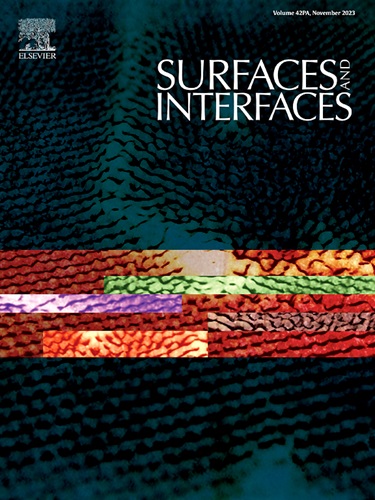基于第一性原理计算的Au/Ni3Al界面强化及断裂机制研究
IF 6.3
2区 材料科学
Q2 CHEMISTRY, PHYSICAL
引用次数: 0
摘要
采用基于密度泛函理论(DFT)的第一性原理计算系统地研究了合金元素偏析对Au/Ni3Al界面的影响。通过全面的原子尺度和电子结构分析,阐明了界面强化、元素偏析行为和断裂起裂的机理。结果表明,桥梁位置(MT)构型具有最大的粘结强度。Si和Ge原子容易从Au表面分离到界面,而Ni和Sn溶质原子在Au基体内表现出优先偏析。当Ni掺杂时,界面的粘附功比未掺杂时提高了16.33%,结合强度得到了显著提高。同时,系统地分析了界面断裂过程中化学键和电子行为的变化。三种界面堆积模式的断裂均发生在Au体相内部,这是由于Au体材料中Au-Au(I)键断裂所致。本研究对研究金基钎料与基材之间的强化、合金元素偏析和断裂行为具有指导意义。本文章由计算机程序翻译,如有差异,请以英文原文为准。

Insight into the strengthening and fracture mechanism of Au/Ni3Al interface via first-principles calculations
The effects of alloy elemental segregation on the Au/Ni3Al interface are systematically investigated employing density functional theory (DFT)-based first-principles calculations. Through comprehensive atomic-scale and electronic structure analyses, the mechanisms of interfacial strengthening, elemental segregation behavior, and fracture initiation are elucidated. The findings indicate that the bridge position (MT) configuration has the maximum bond strength. Si and Ge atoms are easily separated from the Au surface to the interface, while Ni and Sn solute atoms exhibit preferential segregation within the Au matrix. When the Ni is doped, the interfacial work of adhesion increased by 16.33 % compared with the undoped interface, and the bonding strength was considerably improved. Meanwhile, the changes of chemical bonding and electronic behavior during the interfacial fracture are systematically analyzed. The fracture of three interfacial stacking models occurred inside the Au bulk phase, which are caused by the breakage of Au-Au(I) bonds in the Au bulk material. This study is a guide to the strengthening, segregation of alloying elements and fracture behavior between Au-based solder materials and base materials.
求助全文
通过发布文献求助,成功后即可免费获取论文全文。
去求助
来源期刊

Surfaces and Interfaces
Chemistry-General Chemistry
CiteScore
8.50
自引率
6.50%
发文量
753
审稿时长
35 days
期刊介绍:
The aim of the journal is to provide a respectful outlet for ''sound science'' papers in all research areas on surfaces and interfaces. We define sound science papers as papers that describe new and well-executed research, but that do not necessarily provide brand new insights or are merely a description of research results.
Surfaces and Interfaces publishes research papers in all fields of surface science which may not always find the right home on first submission to our Elsevier sister journals (Applied Surface, Surface and Coatings Technology, Thin Solid Films)
 求助内容:
求助内容: 应助结果提醒方式:
应助结果提醒方式:


